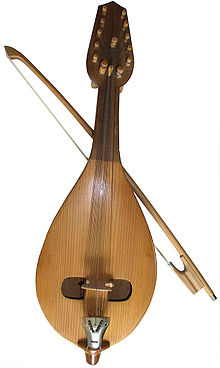Gadulka
Gadulka ( Bulgarian Гъдулка , transcribed Gădulka ) is a string instrument that is played in northern Bulgaria , in the Balkan Mountains (central Bulgaria) and in the Thrace region (southeastern Bulgaria). The gadulka is on the construction of a shell neck loud and belongs to the also painted gusle and plucked Tambura to the three played in the Bulgarian folk string instruments.
Design
The gadulka consists of a bowl-shaped body that tapers to a short straight neck and ends at the vertebrae with a lateral widening to accommodate the posterior vertebrae. The body and neck are cut out of a block of wood. The material used is usually walnut, maple or mulberry wood. The ceiling is made of lighter fir wood and is glued on the edge.
The gadulka is usually strung with three or four strings, rarely more. In earlier times there were also two-string gadulki. The most important function is played by the first string on which the melody is played. The gadulka has three melody strings (mostly tuned in AE A ') and eight to ten sympathetic strings . The sympathetic strings are not bowed or fingered, they are very thin, lie under the melody strings and have the task of increasing the resonance of the notes played. The instrument is supported on the lap while sitting or played with a shoulder strap while standing.
Traditionally, a horsehair-covered wooden bow is used, but a normal violin bow serves the same purpose. The wood of the bow is usually made of cherry wood or willow.
Compared to the violin , the melody strings of the Gadulka are very far away from the neck, so that pressing down on the fingerboard would be impossible - a fingerboard is therefore completely dispensed with, as is an upper saddle . The strings are pressed freely, only touched when grasping, not pressed down. This leads to the rather muffled, specific tone of the instrument, which comes close to the sound of the viola in its low register. The sound production is more difficult than on a violin because the strings are pressed freely.
Mood
The three-string gadulka is the most common. The strings are in the different folklore regions differently Bulgaria voted . The “northern tuning”, in which the first string is tuned to a1, the second to a of the small octave, and the third to e1, is very popular. The melody is mostly played on the first and third strings.
The “Thracian mood” is similar to the northern one. However, the arrangement of the strings is different. The first string is tuned to a1, the second to e1 and the third to a of the small octave. This Thracian gadulka has the relatively largest range. The melody is played on all three strings. The “gypsy mood” is quite popular: first string a1, second e1, third d1. The melody is played mainly on the first two strings. The four-string gadulki are also tuned differently, but basically the relationship between the strings remains similar to the three-string gadulka tunings mentioned. The fourth string is tuned to the third in a second, octave, fifth or fourth.
The range of the Gadulka is small. The Thracian gadulka, for example, which has the largest pitch range, generates tones within a duodecime - from the a of the small octave to the e2. Only very good players can expand the range to two octaves.
distribution
Of the string instruments, the gadulka, an ancient Slavic instrument, is the most common in Bulgaria today. It is the dominant folk instrument in many areas, but is missing e.g. B. in the Rhodope Mountains and in part of the Pirin Mountains . The gadulka is the favorite instrument of the old folk singers to accompany epic and happy songs, but is also used as a solo instrument. In today's folk orchestra, the gadulka takes the place of the symphony orchestra's string instruments. New instruments based on the gadulka have also been introduced. These are the viola gadulka, the cello gadulka and the bass gadulka.
A related three-stringed string instrument in Russia is the gudok . For the origin and distribution of Eastern European strokes in general see: Husle .
literature
- Marie-Barbara Gonidec: The Bulgarian Gădulka. In: Jean Cuisenier: The wedding of Marko. Bulgarian rites and myths. (Series of publications on dendrochronology and building research, Volume 7) Jonas, Marburg 2009, pp. 272f
- Ivan Kachulev: Gadulkas in Bulgaria. In: The Galpin Society Journal, Vol. 16, May 1963, pp. 95-107
